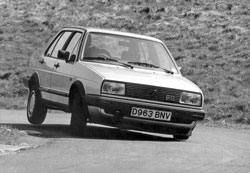|
Confront if you must Hijackers threaten road users as well as air travellers. Anthony Howard gets a lesson in how to cope....
TERRORISM has many targets ranging from Lockerbie-scale
mass tragedies to individual royals, politicians and tycoons. Countering
any of these demands eternal vigilance, common sense, deftness in evasion
and, if the worst comes to the worst, determined preparedness to see off
any assailant.
Mid-air explosions
are dramatic, newsworthy and political hot potatoes. Yet single targets
may be even more vulnerable in a car, where the same principles of
counter-terrorism apply.
Armouring the
vehicles of the great and the rich has long been big business. Though much
of this is useless without the right skills behind the wheel - far more
than conventional chauffeurly virtues such as smooth driving, discretion,
keen polishing and slick door opening.
The methods
adopted are those of Ruben Börjesson (left), one of the world's leading
authorities on anti-hijack driving. He embarked on this speciality at
Sweden's Police Academy more than 10 years ago. His pupils include King Karl Gustav's bodyguards, and he has trained or advised instructors as far afield as the USA, New Zealand, Switzerland, West Germany, Austria and Denmark, as well as police in Britain. Techniques
Sweden may not
have rated high on your list of dangerous countries. But Börjesson
declares: "Your prime minister is alive. Ours was killed. And people who
know about terrorists in Western Europe say they keep their money in
Switzerland and live in Sweden. So we have a problem."
The new course is
distinct from lessons the Centre’s existing programme of lessons in
improving driving skills to match the performance of cars such as the VW
Golf GTI or Ford Sierra Cosworth.
I sampled
Börjesson's techniques while he was working up the course with Silverstone
instructors. He told us: "It can be life or death, but you still have the
laws of the land to comply with.
"You must use your
brain, plan ahead. You should never have an accident because you should
never put yourself in a position to have one. If you do, you're a complete
and utter failure.
"On the other
hand," he smiles, "if you become so paranoid that you see danger
everywhere and won't drive your boss anywhere, you'll be sacked."
The course teaches
two main principles:
1:
How stay out of trouble.
2:
How to get out of it by taking the initiative away from assailants.
Should an attack
occur, you have maybe five seconds to react and half a minute to get away
to safety. This was all too clearly dramatised by a "gunman" lurking in
wait while we took a "ministerial tour" around the Silverstone complex.
When he struck, the ideal pre-emptive response was always to have the
doors locked and the car positioned, ready for a quick forwards getaway
from a confined space.
Or, when
confronted head on, we were shown how to reverse rapidly out of range,
then make a handbrake turn into forward motion for an even quicker
retreat. Where unavoidable, the best means of defence is attack, and pupils are shown how to do this, using old bangers from a nearby scrap yard. Body language
"You have a
weapon," says Börjesson," and that's your car. It's the only help you have
in an emergency. Sometimes it can be dangerous even for you. So you have
to learn how to handle it.
"If there's a road
block where they're expecting you to stop, they've probably been planning
it for two weeks. But you can change all that in five seconds. If you
drive straight at them or reverse fast, you've blown it for them."
Learning to read
the "body language" of other traffic or pedestrians is just as important
to minimising a potential attacker's chances as it is to avoiding
conventional road hazards. If another car draws alongside for a pot shot,
do you try to out accelerate it, ram it, or hit your brakes hard?
Rotten eggs and
tomatoes have often been part of the fun of the hustings, and chucking
paint over a ministerial car is a modern form of dissent, which renders
screen wipers useless.
Börjesson has
thought of that too. He blacks out the windscreen and rear window with
blankets, then urges pupils to find their way backwards and forwards
through a complex high-speed driving test, leaning out of the window and
using the wing mirrors.
Playing dignitary
in the back seat during this performance is pretty sick-making, but it's
preferable to getting stuck, helplessly embattled by the mob.
The aim is to make
this the best tuition of its kind in Britain, so it doesn't come cheap -
around £750 for three days. Its exclusivity is further assured by Joe
Hawkins, the former Detective Inspector who markets the course and
carefully vets all candidates to prevent such know-how falling into the
wrong hands.
Concludes
Börjesson: "The only goal I have is that everyone will be better, and
that's easier with very bad rather than good drivers. The purpose is to
put you under pressure, so you get the feeling. "If you make a mistake on the course, that's not a catastrophe - you'll learn a lot by your mistakes. After all, you're chauffeurs, not racing drivers." Real life
I experienced a
real-life sequel one bright summer afternoon while driving a colleague
back from an event we had attended - and competed in - at Prescott Hill
Climb in Gloucestershire. I
So I overtook them
quickly and, I thought, courteously. A few miles later, a laden truck
pulled out of a quarry and began its crawl up the steep hill with a blind
summit ahead, so I collected first gear and settled for following the
truck to the top.
Next the trio of
cars appeared and the first driver, stupidly I thought, made to overtake.
Not wanting to become embroiled in the accident he was about to trigger, I
backed off and left more distance between my car and the truck. The
newcomer swung in front of me and immediately slowed to a standstill,
while the second car stopped at my right and the third at my rear.
Six large tattooed
bruisers, faces red with beer and sunburn, closed in, wielding hammers and
jemmies. Concluding in those few seconds that they intended to smash the
car to pieces with us in it, I shut the windows and the sunshine roof.
They had us
trapped, but not quite. Luckily for us there was a steep six-foot-high
earth bank at the roadside, instead of the usual dry stone wall. With a
rush of adrenalin I aimed the car along the bank, heeling over at an angle
of 45 degrees, and got on the throttle. The car popped through the narrow
gap like a cork out of a bottle, leaving our new chums gawping as we
legged it up the hill.
My colleague Mr
Cool declared himself unfazed. “I had not a scintilla of doubt that you’d
get us out of that,” he drawled. Oh, sure – any time.
1,220 words copyright © by Anthony Howard |
 A course to impart
evasion driving expertise to professional chauffeurs has been devised at
the John Watson Performance Driving Centre, based at the Silverstone grand
prix circuit.
A course to impart
evasion driving expertise to professional chauffeurs has been devised at
the John Watson Performance Driving Centre, based at the Silverstone grand
prix circuit. knew the
cross-country road well and, when I saw a group of three rather slow cars
ahead, I realised we could be stuck behind them for 10 miles.
knew the
cross-country road well and, when I saw a group of three rather slow cars
ahead, I realised we could be stuck behind them for 10 miles.